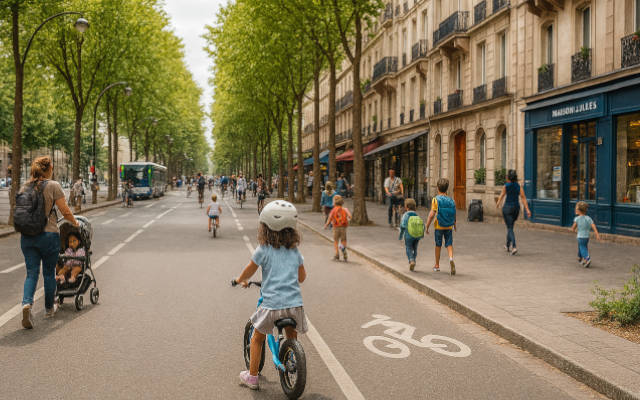Putting Children First: Lessons from Paris for Atlanta

Copilot-generated image of an idealized, child-centric street in Paris
By EVWorld.com Si Editorial Team
In the heart of Paris, a quiet revolution is reshaping how people move through the city - not with flashy infrastructure or high-tech transit, but with a simple, powerful idea: design mobility around children. This child-first approach is transforming urban life, and for cities like Atlanta, it offers a compelling blueprint for a safer, more inclusive future.
Paris's mobility overhaul began with a recognition that streets dominated by cars were failing the most vulnerable. Children faced daily risks walking to school, playing in neighborhoods, or simply crossing the street. In response, city planners reimagined public space. Sidewalks were widened, car traffic was reduced near schools, and green corridors replaced asphalt. The goal was not just safety - it was dignity, autonomy, and joy for young citizens.
This shift has had ripple effects far beyond childhood. When cities prioritize children, they inadvertently create better conditions for everyone: seniors, people with disabilities, cyclists, and pedestrians. Paris's redesigned streets now support micromobility - e-bikes, scooters, and cargo bikes - while calming traffic and reducing emissions. The city's commitment to low-speed zones and protected lanes has made it easier for families to navigate without cars, fostering independence and community connection.
Atlanta, by contrast, remains heavily car-dependent. Many neighborhoods lack sidewalks, bike infrastructure is fragmented, and public transit is underfunded. For children, this means limited freedom and heightened danger. The daily school commute often involves long car rides, traffic congestion, and exposure to pollution. It is a system built around vehicles, not people.
But change is possible. Atlanta can draw direct lessons from Paris's success. First, it must rethink zoning and land use. Mixed-use development near schools and parks encourages walking and reduces the need for long car trips. Second, the city should invest in protected bike lanes and pedestrian infrastructure - not just downtown, but in underserved neighborhoods where mobility gaps are most severe.
Third, Atlanta must embrace a cultural shift. Mobility is not just about engineering; it is about values. When cities put children at the center of planning, they signal a commitment to equity, sustainability, and public health. As David Edwards writes in the AJC, 'A city where children thrive is a city with a bright future.' That future depends on bold choices today.
There are signs of progress. Atlanta's BeltLine project has opened up new corridors for walking and biking, and some neighborhoods are experimenting with traffic calming and school zone improvements. But these efforts need scale and urgency. Paris did not wait for perfect conditions - it acted with conviction, guided by a moral imperative to protect and empower its youngest residents.
Atlanta's leaders, planners, and citizens have an opportunity to do the same. By listening to families, studying global models, and investing in inclusive design, the city can build a mobility system that works for everyone. That means fewer cars, more green space, safer streets, and a renewed sense of community.
In the end, the question is not whether Atlanta can follow Paris's lead - it is whether it will. The stakes are high, but the rewards are profound. A child-first city is not just more livable; it is more just, more resilient, and more human. And in a world facing climate, health, and social challenges, that kind of city is exactly what we need.
Sources
Original Backlink
Views: 96
Articles featured here are generated by supervised Synthetic Intelligence (AKA "Artificial Intelligence").
